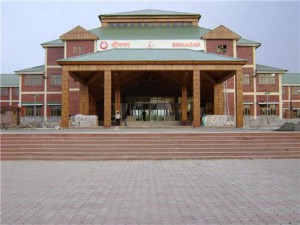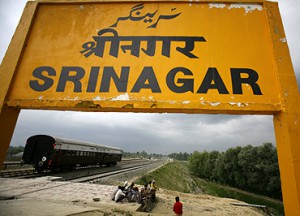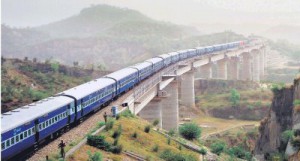 Srinagar railway station or Nowgam railway station is a railway station of the city of Srinagar in the Indian state of Jammu and Kashmir.The station is part of the Kashmir Railway, which once completed, will connect the city to the Rail network of India. Currently, services are to Baramulla and Banihal. The railway once fully completed is expected to increase tourism and travel to the Kashmir Valley.The work of last leg Chenab Bridge is in final stages and is expected to be completed by 2017. Once completed, Srinagar will have 24X7 connectivity with rest of Indian mainland.
Srinagar railway station or Nowgam railway station is a railway station of the city of Srinagar in the Indian state of Jammu and Kashmir.The station is part of the Kashmir Railway, which once completed, will connect the city to the Rail network of India. Currently, services are to Baramulla and Banihal. The railway once fully completed is expected to increase tourism and travel to the Kashmir Valley.The work of last leg Chenab Bridge is in final stages and is expected to be completed by 2017. Once completed, Srinagar will have 24X7 connectivity with rest of Indian mainland.
The station has been built as part of the Kashmir Railway mega project, intending to link the Kashmir Valley with Jammu Tawi and the rest of the Indian railway network.
Notification For Srinagar
The station features Kashmiri wood architecture, with an intended ambience of a royal court which is designed to complement the local surroundings to the station. Station signage is predominantly in Urdu, English and Hindi. The IRCTC intends to build a hotel within close proximity to the site.
 Due to tough terrains , rail links were difficult to be set up in various part of Jammu and Kashmir state but despite of different odds, Srinagar, the summer capital of Jammu & Kashmir State and one of the Most Spectacular cities of India Showcasing Mother Nature’s Marvel, has got a Mystic railway station to serve people through rail link. This station is called srinagar station or Nowgam Station and is located about 8 km away from the city overlooking beautiful landscapes of Kashmir Valley.
Due to tough terrains , rail links were difficult to be set up in various part of Jammu and Kashmir state but despite of different odds, Srinagar, the summer capital of Jammu & Kashmir State and one of the Most Spectacular cities of India Showcasing Mother Nature’s Marvel, has got a Mystic railway station to serve people through rail link. This station is called srinagar station or Nowgam Station and is located about 8 km away from the city overlooking beautiful landscapes of Kashmir Valley.
How to Apply to Srinagar
The Railway Station at Nowgam or Srinagar Railway Station serves as a link between kashmir Vally and Jammu Tawi is connected to major parts of India through rail link , it becomes easy for the travelors to come to srinagar via train. The station of srinagar is built to complement with the beautiful surroundings. the design looks like a royal court and it is made of wood. The signs of this station are given three languages like Urdu, Hindi and English. IRCTC has plans to construct a hotel close to srinagar Railway station so that travelors get premium staying facilities after they reach here.There are three platforms in this station and four tracks for running the coaches. Parking facility is available in the platform . The station code of srinagar railway station is SINA and it was opened up in 2008.
 About Srinagaer:
About Srinagaer:
Folk etymology draws the city name from two Sanskrit words: śrī (“glory, prosperity”, a name for the goddess Lakshmi) and nagar (“city”), which would make “City of Lakshmi” (or, “City of Prosperity”).However, the earliest records mention the name as siri-nagar which in turn is a local transformation of the original Sanskrit name sūrya-nagar, meaning “City of Sun” (or, of sun god).
Vacancy Notification Srinagar
After India and Pakistan’s independence from Britain, villagers around the city of Poonch began an armed protest at continued rule of the Maharaja on 17 August 1947. In view of the Poonch uprising, certain Pashtun tribes such as Mehsud and Afridi from mountainous region of Khyber Pakhtunkhwa of Pakistan and with its collusion, entered the Kashmir valley to capture it on 22 October 1947.[14] The Maharaja, who had refused to accede to either India or Pakistan in hopes of securing his own independent state, signed the instrument of accession in exchange for refuge on 26 October 1947, as Pakistani-backed tribesmen approached the outskirts of Srinagar. The Accession was accepted by India the next day. The government of India immediately airlifted Indian troops to Srinagar and prevented the tribesmen from reaching the city.
In 1989, Srinagar became the focus of the Kashmiri uprising against Indian rule and the Indian military, which has been present since 1990, and the area continues to be a highly politicized hotbed of separatist activity with frequent spontaneous protests and strikes (“bandhs” in local parlance). On 19 January 1990, the Gawakadal massacre of at least 50 unarmed protestors by Indian forces, and up to 280 by some estimates from eyewitness accounts, set the stage for bomblasts, shootouts, and curfews that characterized Srinagar throughout the early and mid-1990s. Further massacres in the spring of 1990 in which 51 unarmed protesters were allegedly killed by Indian security forces in Zakura and Tengpora heightened anti-Indian sentiments in Srinagar.[18] As a result, bunkers and checkpoints are found throughout the city, although their numbers have come down in the past few years as militancy has declined. However, frequent protests still occur against Indian rule, such as the 22 August 2008 rally in which hundreds of thousands of Kashmiri civilians protested against Indian rule in Srinagar.Similar protests took place every summer for the next 4 years. In 2010 alone 120 unarmed protestors were killed by police and CRPF, most recently protest following the execution of Afzal Guru in February 2013.
